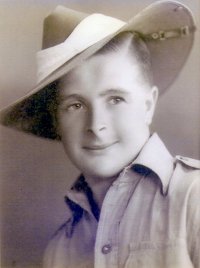| Man on the Skyline Peter 'Doc, Wesley Service Details
Peter Wesley joined the 2nd AIF in 1945. Served with British CommonwealthOccupation Forces (BCOF) (Signals) till March 1947. Re-enlisted in K Force(Korea) in January 1952 and completed two tours of duty in Korea, later transferring to the Australian Regular Army (ARA). Discharged in 1960with the rank of Corporal. Married Kazue Kato (Kay) in Japan 1953, has twogrown up children. Formerly a senior officer with the Australian TaxationOffice (ATO), he established his own chartered accountancy practice inSydney and Canberra, with associated and correspondent firms throughoutAustralia and New Zealand. Although past mandatory retiring age, Petercontinues to work and devotes much of his time, in a voluntary capacity toVeterans'associations. | 
|
It was August 1952, summer in Korea. 1 was a very new Digger in C Company,3 Battalion Royal Australian Regiment (3 RAR), who were forward on Hill97, a few hundred yards across the valley of paddy fields from'Charlie', the nickname for the Chinese communist troops. In front of ourposition were minefields; on our left was D Company and on our right was 1Battalion RAR. Both were separated from us by narrow valleys. Behind us,on a higher feature, Hill 187, was A Company 3 RAR, whom we had relievedas forward company of the battalion a few days previously. The war hadbecome static. We were dug in on the rear slopes of the steep hillyfeatures. Back home in Aussie,'civvies'(civilians) would call these hillsmountains.
During the day, activity was at a minimum, as far as we in the companywere concemed. Nevertheless, Charlie continued to brighten up our liveswith his accurate mortar fire. At night we did patrols in the valley infront of us, manned outposts at the mine gaps, or manned monotonouspicquets in fighting pits on the hill. As we were under strength, thesepicquets were rather long, lasting for nearly four hours.
During the early part of my shift on this particular night, I had shownseveral of the boys, who were a little'stinko', the way totheir'hoochies', as we called our dug-outs. They had been relieved of allduties, as they were going home next day and in celebration had scroungedsome extra beer. In the early hours of the morning, as my picquet wasdrawing to a close, I was thinking of the information given by a prisoner.It was that several nights previously a small enemy patrol had sneakedup'Happy'Valley', which separated us from D Company next door, to look atthe new jeep head which was being built. I was really tired and lookingforward to a brew of coffee, then bed.
The thought made me turn towards my hoochi. I saw the form of a man on theskyline. I called out to him. There was a reply, but I could notunderstand it. Assuming it was another of the lads going home that day anda little drunk, I strolled up to the communication trench, or crawltrench, as we described them, to help him find his way back to his hoochi.Suddenly, I froze in my tracks. I was looking at a yellow, slant-eyed mandressed in a green uniform.
Knowing that all the Korean Houseboys were inreserve and did not leave their hoochies at night, I thought I was seeingmy first Red soldier at really close range. For a moment, as frightened ashell, I stood in the crawl trench looking a him, not sure what to do. Ihad no weapon of any kind with me; everything was in the fighting pit. Istared at him, and he stared at me. Somehow, I managed to call out to mymate, who was sleeping in my nearby hoochi. Clad only in underpants, hecame running out, cursing at having his sleep interrupted. He broke thetension, just as I was about to grapple with the stranger. 'You silly................... Why aren't you in your hoochi? You'll get your............. self shot walking around, at this time'. Then to me: 'Youknow him, don't you? Lieutenant Soong's interpreter.' I did; and breathedagain.
Lieutenant Soong was a South Korean officer who had been attached to thebattalion for nearly two years. He used a wireless set to intercept theChinese Red's messages, and this 'interloper' was his interpreter. Theinterpreter would translate the signals from Chinese to Korean, thenLieutenant Soong would write them down in English, These two men, who werealways with the most forward company of the battalion when we were in theline, proved to be a great help to the Aussie battalions, as well a toother United Nations units. The interpreter, now a merchant in Seoul,never left his hoochi again at night, and a rum ration not authorised byLieutenant Colonel Hughes then Commanding Officer of the battalion, wasdrunk by one badlyscared Digger, who was lucky enough to be in charge ofthe company's rum at the tirne.
Lieutenant Soong was later stationed at the Ist Commonwealth DivisionalHead Quarters, helping with the administration of South Korean soldiers,integrated with all Commonwealth Units during the last months of the war.He said he hopes, some day, to visit Australia, to continue universitystudies commenced before the war in Korea. He is sure of a good welcome byme if he ever makes the trip. |
